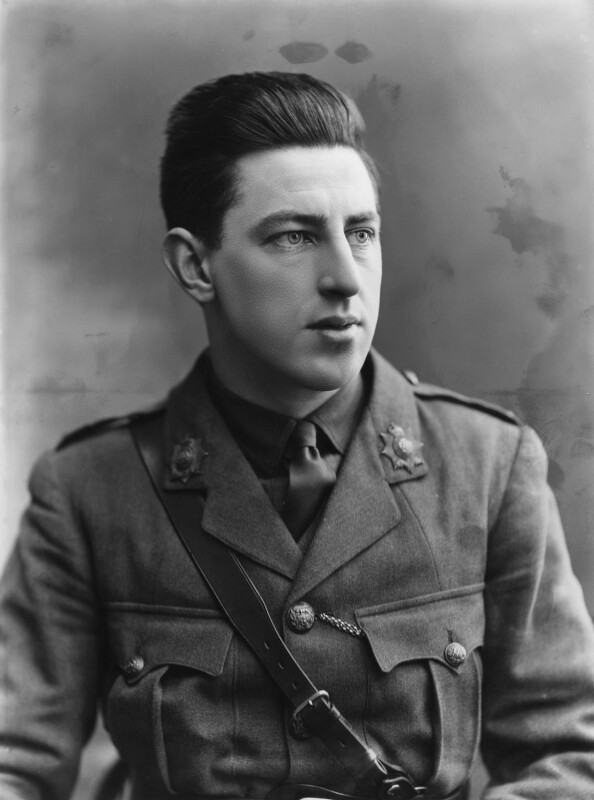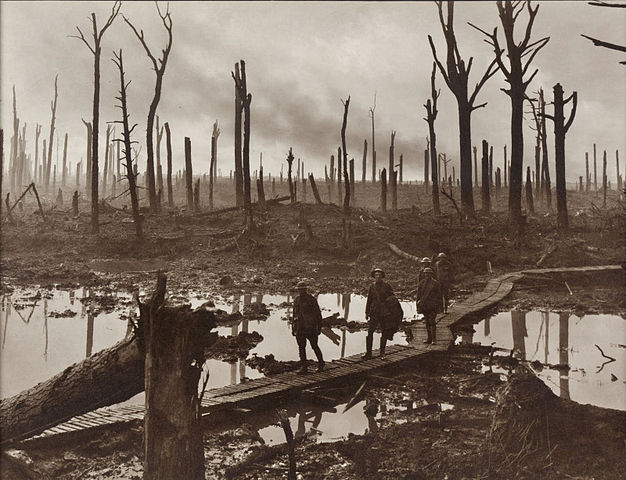John and Paul Nash #
Both John and Paul Nash were painters and official war artists commissioned during the First World War.[1] World War I brought about the possibility of death, brutality and destruction, with new machinery of war. In the art world, it created an openness to abstraction and surrealism.

Paul was educated at St Paul’s School in London and later Paul attended the Slade School of Fine Art, from 1910 to 1911.[2] At the time, The Slade was considered much more modern than the Royal Academy of Arts. He struggled with figure drawing and concentrated on landscape painting instead,[3] using his time to socialise with other artists such as Ben Nicholson, Stanley Spencer, Mark Gertler, Dora Carrington and Christopher R. W. Nevinson.[2:1] In 1914, shortly after the start of the war, Paul reluctantly enlisted in the Artists’ Rifles.[4] Paul was a commissioned officer, who was sent to the Western Front in late February 1917 and took part in the offensive at Ypres. Paul arrived at the Ypres Salient at an unusually quiet time. At twilight, as he patrolled the trenches, he had time to absorb the strange beauty of the battlefront landscape.[5] In late May of the same year, he broke his ribs and was invalided home. Having returned home, his exhibition at the Leicester Galleries of fifty-six pieces of work – five oil paintings, five lithographs and numerous sketches on brown paper – was well-received.[6] Paul returned to the Western Front in November 1917 as an official war artist, with a servant and personal chauffeur, allowing him to dodge artillery shells and access the trenches more safely,[7] thus his experience of the war was much ‘softer’, he was noting down and sketching events that he witnessed. It was very unusual for a soldier to have such a level of service during the war.
John attended Wellington College and was not formally trained as an artist, and his experience of the war was much rougher than Paul’s. John never became a commissioned officer, as he was an experienced soldier and a skilled machine gunner, training people in machine guns and mortars.
Over the Top, John Nash, 1918 #


Over the Top is a 1918 oil-on-canvas painting by John Nash, one of very few officially commissioned works, commemorating the 1st Artists’ Rifles counterattack near Marcoing on the morning of 30th December 1917. He experienced the attack first-hand and recalled it as such: “It was in fact pure murder and I was lucky to escape untouched.”[8][7:1][9] On the left, a red earth duckboard-lined trench, which John chose to depict not as a neatly engineered line but as a gash in the wounded earth, zig-zagging and gouging the winter landscape,[8:1] stretches away from the viewer. A group of soldiers clamber from the trench into a snow-covered landscape, going ‘over the top’, with two already lying dead in the trench and another fallen with his face down in the snow. Those who have survived walk forwards to their fate without looking back, beneath a grey, stormy sky, with billowing clouds created by shell and gunfire in the distance. The legs of a soldier in the bottom right of the painting suggest something that many soldiers of the First World War experienced: how “cheap” their lives were deemed to be. The painting is a critique of the lack of strategic thinking and organisation in the trenches, with the only answer to the mechanized war being to throw more and more men at the machines. Two studies held by the Imperial War Museum show the carefully balanced composition, with each quarter of the painting depicting a separate violent aspect of the war.[10]
The Menin Road, Paul Nash, 1919 #


The Menin Road is a large oil painting by Paul Nash commissioned in April 1918 by the British War Memorials Committee that depicts a First World War battlefield, intended for display at the national Hall of Remembrance, which was never built. The building was to be designed to accommodate a series of paintings based upon the dimensions of the large triptych, The Battle of San Romano by Paolo Uccello. Paul started this painting in June 1918, working in a herb drying shed, in which his brother John was working at the same time on his own painting, Over the Top.[9:1] The work presents a devastated battlefield with rain-filled shell-holes after the Battle of the Menin Road Ridge, with the trenches flooded, the “black dying trees”, as Paul described them.[11] The shattered apocalyptic sky is lit by unearthly beams of light. Two figures at the centre of the painting make their way along a tree-lined Menin Road. The foreground is filled with concrete blocks, barbed wire and corrugated iron.[12] In this work, Nash has combined his graphic ability with highly developed design, by spreading the composition all over the canvas, creating an anti-hierarchy, where the corners contain some of the most important and hideous images in the narrative, and using a colour scheme similar to that of Flemish tapestry and The Battle of San Romano.[13]
Further reading #
References #
Copyright notice: images on this page do not belong to me. Each image is linked to its respective source; each image caption contains licensing information. Most are in the public domain, usage permissible under non-commercial/educational use terms. Please consult image copyright holders, not me, about using these images yourself.
“The Powerful Western Front Paintings Of The Nash Brothers”. Imperial War Museums. Retrieved 2019-01-07. ↩︎
“Paul Nash biography”. Piano Nobile. Retrieved 2019-01-07. ↩︎ ↩︎
“Paul Nash 1889-1946”. Tate. Retrieved 2019-01-07. ↩︎
“Paul Nash | British painter”. Encyclopedia Britannica. Retrieved 2019-01-07. ↩︎
“Paul Nash, artist of powerful First World War paintings”. Tyne & Wear Archives & Museums Blog. Retrieved 2019-01-07. ↩︎
Paul., Gough, (2010). A terrible beauty : British artists in the First World War. Bristol: Sansom & Co. ISBN 9781906593001. OCLC 559763485. ↩︎
Jones, Simon (2017-12-31). “‘Pure murder’: John Nash’s ‘Over the Top’”. Retrieved 2019-01-08. ↩︎ ↩︎
Willette, Jeanne. “John Nash: The Soldier’s War | Art History Unstuffed”. Retrieved 2019-01-08. ↩︎ ↩︎
Slocombe, Richard (2014-07-02). “‘Over the top’ and resigned to their fate”. Imperial War Museum. ISSN 0307-1235. Retrieved 2019-01-08. ↩︎ ↩︎
“Study for ‘Over The Top’ (IWM ART 1656)”. Imperial War Museums. Retrieved 2019-01-08. ↩︎
Drąg, Wojciech; Krogulec, Jakub; Marecki, Mateusz (2016). War and Words: Representations of Military Conflict in Literature and the Media. Newcastle upon Tyne: Cambridge Scholars Publishing. p. 42. ISBN 9781443894241. OCLC 949669829. ↩︎
“The Menin Road”. Imperial War Museums. Retrieved 2019-01-08. ↩︎
Passchendaele in perspective : the Third Battle of Ypres. Liddle, Peter. London: Leo Cooper. 1997. ISBN 0850525888. OCLC 38008606. ↩︎